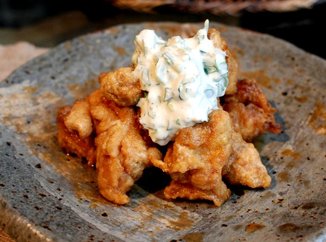
http://www.cnngo.com/tokyo/eat/40-tokyo-foods-we-cant-live-without-090648
40 Tokyo food we can’t live without by Melinda Joe, W. David Marx, Darryl Wee and Misha Janette
My Thoughts:
This is a little annoying because basically it names a bunch of food including basashi, tempura, tonkotsu style ramen, and satsuma-age (all that are technically Kyushu originated foods). Other foods on the list include foods that are widely considered “Osaka” and “Okinawa” foods. However the title of this is “Tokyo Food”. Basically, food that can be found in Tokyo but so many foods that have deep ties to elsewhere in Japan, places that are very conveniently ignored. I think that since Japan is so small in comparison to at least the USA, it is easy to write off Japan embodied in places like Tokyo and Osaka. However, the size of Japan doesn’t really seem to have changed the variety in culture and all the regions that are spread through the country. How people can so easily generalize an entire country boggles me.
http://whiteonricecouple.com/travel/tonkotsu-kyushu-ramen/
KYUSHU STYLE RAMEN: IN THE EHART OF TOKYO Todd and Diane Blog
“Kyushu style ramen is notibly different from other style of ramens because of it’s rich, cloudy and hearty broth that’s mostly done with Tonkotsu (pork bone) broth and sometimes combined with a chicken and/or vegetable broth. Kyushu broth is deep, flavorful and it is balanced nicely with a beautiful sheen of fat on top. The depth of flavor and richness of Kyushu ramen broth is definitely for the hungry and the hearty.
Each sip of the distinctly heavier and flavorful Kyushu ramen broth was a fuel for our souls, especially after shaking off the jet lag and walking for about 2 hours in the flamboyant Shibuya district.”
“Although we were in Tokyo, (Kyushu is Japan’s most southern-western island) the man who opened this shop was a Kyushu local and brought his homeland specialty to Japan’s thriving epicenter of Tokyo. What a treat for us to be able to experience such a delicious regional specialty in the heart of the street fashionably-stylish Harajuku. Old Japan meets new Japan. Thanks Chika, for the great tour, wonderful company and delicious ramen experience.”
My Thoughts:
Kyushu doesn’t ever seem to make it past the sidelines in the mind of the Japanese who live elsewhere. There are always these references, like the one above, to it being “Old Japan” or agricultural or even “hillbilly”. In the above passages, it is nice to see Kyushu in a positive light. They recognize how it is “a treat” to be able to eat Kyushu style ramen in the heart of Tokyo. Then they say “Old Japan meets new Japan”, which is interesting because they are labeling both Tokyo and Kyushu. Just why exactly Kyushu is always referenced to as “old” is what I’m curious about finding proof of.
http://www.japanesefoodreport.com/2008/05/kyushu-style-fried-chicken.html
KYUSHU STYLE FRIED CHICKEN by Harris Salat (Japanese Food Report)
(this is chicken nanban)
“She [Takako Kuratani] just visited New York and one of the things she brought with her was a slender red notebook -- her own personal cookbook, where she records her recipes and cooking inspiration. While she was here, Takako planted herself in a kitchen, cracked opened that little red book and prepared a wonderful homey dinner for a bunch of friends. Her theme: the down-home cooking of Kyushu, Japan's own Deep South.”
My Thoughts:
This article is a little suspicious because I tried finding more information on this said “prodigious chef”, Takako Kuratani, and really couldn’t find anything else except for someone’s slideshow presentation that referenced this same a blog/article. So, I’m not so sure what to think... however, I would like to use the quote about the “Deep South” just because it supports the idea of everyone vaguely referencing to Kyushu as the country, the south, the old japan etc....
http://blog.japancentre.com/2012/07/09/jaff-japan-centres-third-japan-food-festival-27th-july-12th-august/
Japan Centre JAFF: Japan Centre’s third Japan Food Festival (Kyushu is absolutely Yokaromon)
“Kyushu has been selected as JAFF’s special region for a number of reasons: it is home to breath-taking and very diverse scenery, which includes ancient forests, sandy beaches, sweeping mountains and active volcanoes. These volcanoes are the reason why Kyushu is often referred to as the hot spring capital of Japan. Thanks to its moderate climate and fertile soil, the island is also rich in fresh produce. All this, together with the island’s long history as a centre for international trade has made Kyushu a true culinary melting pot.”
My Thoughts:
This is promoting Kyushu’s food cultures for the Japan Food Festival, so it pin points some of the main traits of Kyushu (geography, the volcanoes, long history, trade etc). I can probably just use this as support the image of Japan, but this is with more attention to the actual details that are often ignored in the generalization of Kyushu.
 RSS Feed
RSS Feed